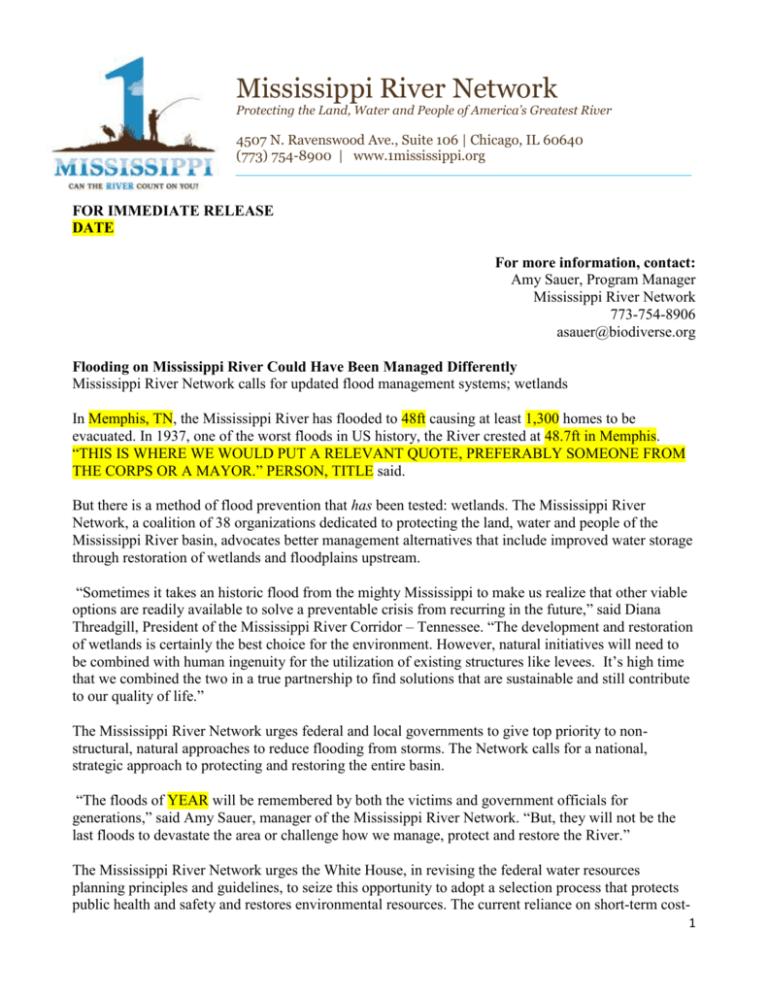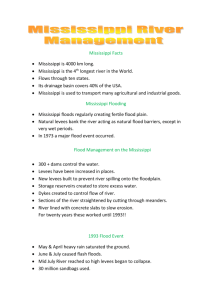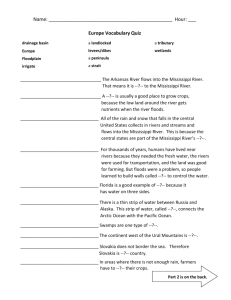Mississippi River Network Protecting the Land, Water and People of
advertisement

Mississippi River Network Protecting the Land, Water and People of America’s Greatest River 4507 N. Ravenswood Ave., Suite 106 | Chicago, IL 60640 (773) 754-8900 | www.1mississippi.org FOR IMMEDIATE RELEASE DATE For more information, contact: Amy Sauer, Program Manager Mississippi River Network 773-754-8906 asauer@biodiverse.org Flooding on Mississippi River Could Have Been Managed Differently Mississippi River Network calls for updated flood management systems; wetlands In Memphis, TN, the Mississippi River has flooded to 48ft causing at least 1,300 homes to be evacuated. In 1937, one of the worst floods in US history, the River crested at 48.7ft in Memphis. “THIS IS WHERE WE WOULD PUT A RELEVANT QUOTE, PREFERABLY SOMEONE FROM THE CORPS OR A MAYOR.” PERSON, TITLE said. But there is a method of flood prevention that has been tested: wetlands. The Mississippi River Network, a coalition of 38 organizations dedicated to protecting the land, water and people of the Mississippi River basin, advocates better management alternatives that include improved water storage through restoration of wetlands and floodplains upstream. “Sometimes it takes an historic flood from the mighty Mississippi to make us realize that other viable options are readily available to solve a preventable crisis from recurring in the future,” said Diana Threadgill, President of the Mississippi River Corridor – Tennessee. “The development and restoration of wetlands is certainly the best choice for the environment. However, natural initiatives will need to be combined with human ingenuity for the utilization of existing structures like levees. It’s high time that we combined the two in a true partnership to find solutions that are sustainable and still contribute to our quality of life.” The Mississippi River Network urges federal and local governments to give top priority to nonstructural, natural approaches to reduce flooding from storms. The Network calls for a national, strategic approach to protecting and restoring the entire basin. “The floods of YEAR will be remembered by both the victims and government officials for generations,” said Amy Sauer, manager of the Mississippi River Network. “But, they will not be the last floods to devastate the area or challenge how we manage, protect and restore the River.” The Mississippi River Network urges the White House, in revising the federal water resources planning principles and guidelines, to seize this opportunity to adopt a selection process that protects public health and safety and restores environmental resources. The current reliance on short-term cost1 benefit analysis must be abandoned as the fundamental driver for federal water resources planning. The Administration must also require the use of less environmentally damaging alternatives, including nonstructural, water efficiency and restoration approaches. “After Iowans suffered two 500 year floods in the past 18 years, it is clear that focusing flood protection on stronger levees and flood walls is not enough,” said Susan Heathcote, Water Program Director at Iowa Environmental Council. “Long term development planning along rivers must include moving people and structures out of harm’s way and allowing wetland and floodplain areas to perform their natural function—to absorb and slow the river’s flow during spring floods.” In addition to environmental services like filtering pollutants, wetlands act like giant sponges, absorbing excess rainwater before it even has a chance to get the River. Scientists estimate that returning some lands in the Upper Mississippi River basin to their original form—wetlands—would significantly reduce future flooding. “After the devastating floods of 1927, Americans demanded that the federal government take action. This action resulted in the engineered system that we have today,” said Matt Rota, Director of Science and Water Policy at the Gulf Restoration Network. “It’s time for our leaders to reexamine that system. By incorporating wetlands and using floodplains the way they were intended, we can better protect American lives, livelihoods and resources.” #### The Mississippi River Network: Headwaters to the Gulf is a coalition of 38 organizations dedicated to protecting the land, water and people of the Mississippi River basin. It is managed by Biodiversity Project and supported by McKnight Foundation and the Walton Family Foundation. For more information on the Network, visit: www.1mississippi.org. 2







